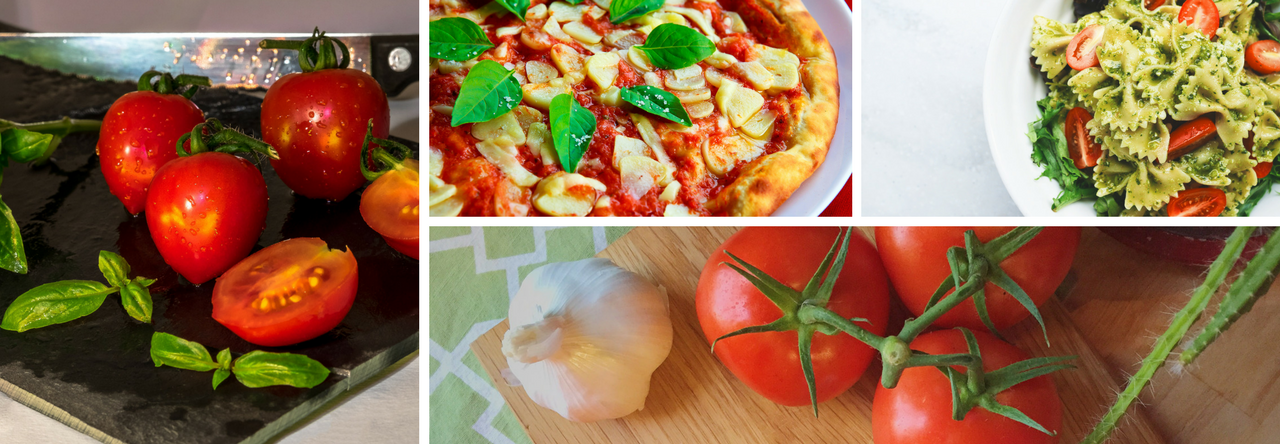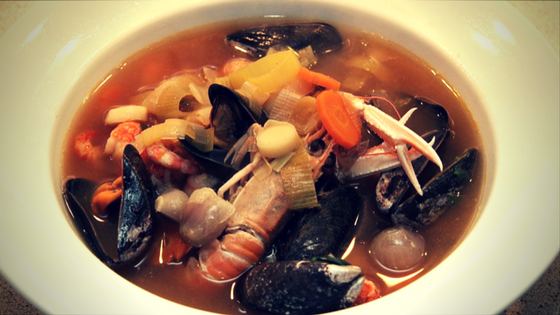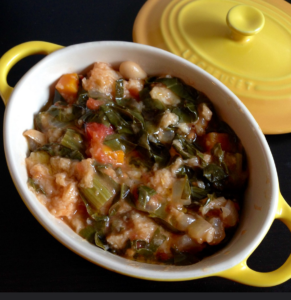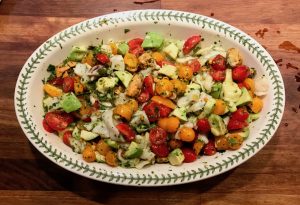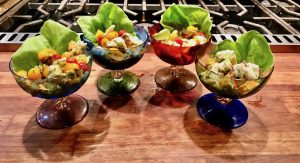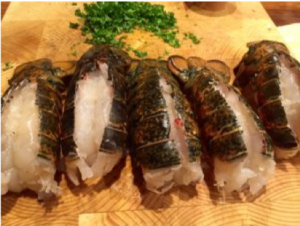I was in San Francisco in a famous Italian restaurant many years ago and saw a menu item called Cioppino. I had never heard of it. Out of curiosity I ordered it. It was a variation of a classic Southern Italian fish soup in a tomato base, but they had put too much tomato!
You can use just about any combination of seafood to make a good zuppa di pesce, but the essential ingredients are the squid, mussels, and shrimp. Fishermen like using small fishes, but they are full of bones. So, the recipe I use has no bones; nobody chokes, and it is delicious.
This recipe is best when prepared a day before you wish to serve it because the flavors blend together over time. So I suggest you make it in abundance since it will be good for a couple of days. It takes only 15 minutes to prepare!
Ingredients
- ½ bunch fresh, flat-leaf Italian parsley, chopped
- 3 cloves garlic
- 1⁄3 chopped onion, red
- Hot small Calabrian or Hawaiian or Thai peppers (1 or more)
- ¾ cup extra-virgin olive oil
- 1 sprig of fresh rosemary
- 1 box of Pomì (750g) chopped tomatoes or homemade canned tomatoes and fish broth (see below) or water.
- 2 pounds of squid (tubes and legs; slice the tubes into ½ inch segments)
- Two large shrimp per person, shells on, but with the backs sliced
- 1 and ½ pounds of fresh mussels –the most critical ingredient!
- ¾ pound fish steak, such as swordfish, Marlin, tuna, Ono, or any fish that has a firm texture and cut 1 inch thick. Cut in cubes of about 1 inch.
- ½ pound of sea scallops
- 2 – 4 soft shell crabs (if in season) or whatever fish you like (except octopus)
- 1 cup dry white wine
- 2 cups fish broth (optional)
- Salt and pepper to taste
Preparation
- In a large heavy-bottomed pan with a cover, gently sauté the cloves of crushed garlic in about 3/4 cup of extra-virgin olive oil. Remove the garlic cloves as soon as they take on color.
- Add the squid to the skillet together with the chopped parsley, hot pepper, and chopped red onion. Cook for 2 minutes, mixing often–yes I do not take out the “pink water” that comes out of of the squid here!
- Add the rest of the seafood to the pan and cook for 2 more minutes, mixing often.
- Add 1 cup of dry white wine. Cover the pan for 1 minute.
- Remove the cover and allow the wine to evaporate for about 30 seconds.
- Add 1 full box of Pomì chopped tomatoes, along with an equal amount + half (i.e., fill in the box of Pomì with water, and next time fill it to half) of water, or better, fish broth that you should always have in your freezer. Also add the rosemary.
- Gently stir all the ingredients together. Cover the pan and allow the ingredients to come to a light boil.
- Immediately turn the heat to low or medium depending on the power of your stove, keeping the cover on. Cook for another 10 minutes. Be sure it does not boil during this time or the fish will become hard and dry.
- Turn off the fire and move the pot to a cool burner, add salt and freshly ground black pepper to taste, and let sit for at least 20 minutes.
- Serve over thick toasted bred brushed with a clove of garlic –if you like garlic. Buon appetito!
Suggested Wine Pairing: Arneis, Gavi, Greco di Tufo, Vermentino, no more than 2 years old, cold. Some people recommend red wine with a fish soup. Taste is taste! If you like a red wine, try a good Cirò, Chianti, or Barbera, or Pinot Noir, but stay away from Merlot and Cabernet!
Italiano: Zuppa di Pesce
Molti anni fa ero a San Francisco in un famoso ristorante italiano e ho visto una voce di menu chiamata Cioppino. Non ne avevo mai sentito parlare. Per curiosità l’ho ordinato. Era una variazione di una classica zuppa di pesce dell’Italia meridionale a base di pomodoro, ma avevano messo troppo pomodoro!
Per una buona zuppa di pesce, puoi usare praticamente qualsiasi combinazione di frutti di mare, ma gli ingredienti essenziali sono i calamari, le cozze e i gamberi. I pescatori la fanno con pesci piccoli, tipo scorfano, ma questi sono pieni di spine. La ricetta che uso non ha spine; nessuno soffoca ed è deliziosa.
Questa ricetta è meglio preparalrla il giorno prima di servirla perché i sapori si fondono ed e` piu` buona. Vi suggerisco percio di farla in abbondanza perche` sara buona per almeno 2-3 giorni.
Ingredienti
- ½ mazzetto di prezzemolo “italiano” fresco a foglia piatta, tritato
- 3 spicchi d’aglio
- 1⁄3 cipolla tritata, rossa
- Peperoncini piccanti calabresi o hawaiani o tailandesi (1 o più)
- 180 ml (3/4 di cup) di olio extravergine di oliva
- 1 rametto di rosmarino fresco
- 1 scatola di pomodori Pomì schiacciati –o conserva fatta in casa- e brodo di pesce (vedi sotto) o acqua.
- 1/2 kg di calamari o seppie (tubi e tentacoli; affettare i tubi in cerchi di 1 cm)
- Due gamberi grandi a persona con il guscio, ma con il dorso tagliato cosi s’insaporiscono
- ½ kg di cozze fresche
- Una bistecca di pesce di circa 400 g, tipo pesce spada, marlin, tonno, Ono o qualsiasi pesce che abbia una consistenza soda e tagliato a cubett1 di 2 cm circa
- 250 g di capesante (muscoli)
- 2 – 4 granchi dal guscio molle (se di stagione) o qualsiasi altro tipo di crostaceo o pesce (tranne il polpo)
- 250 ml di vino bianco secco
- 500 ml di brodo di pesce (opzionale) o acqua. Sale e pepe a piacere
Preparazione
- Soffriggere in olio (quanto basta da coprire il fondo della padella per circa 3 – 4 mm, aglio. Togliere appena prende colore.
- Aggiungere prezzemolo tritato (1 pugno), 1 o più peperoncini piccanti, 1⁄3 di cipolla rossa tritata, e le seppie, tubi tagliati a rondelle tentacoli interi. Soffriggere (fuoco forte) 2 minuti.
- Aggiungere il resto del pesce. Girare spesso, soffriggere altri 2 minuti.
- Aggiungere 1 cup di vino bianco secco, coprire 1 minuto, scoperchiare e fare evaporare 30 secondi.
- Aggiungere 1 box di Pomì “crushed” o “meglio” stessa quantità di conserva di pomodori fatti in casa, e un una quantità e mezza di acqua, o meglio di brodo di pesce fatto in casa e un rametto di rosmarino. (Cioe` se avete usato un box di Pomi`, riempite il box di Pomì di brodo di pesce o d’acqua e poi riempitelo di nuovo solo a meta` e versate sul pesce).
- Mischiare coprire e fare cuocere per dieci minuti a fuoco basso o medio-dipende dalla cucina- l’importante e ‘che non bolla sennò rovinate tutto.
- Spegnere il fuoco, aggiungere sale e pepe e muovete la padella su un fornello freddo e lasciate riposare 20 minuti o più (meglio farla il giorno prima ha più sapore).
- Servite su una fetta spessa di pane tostato su cui avete passato un po’ d’aglio (se vi piace).Buon appetito!
Vino: Un buon bianco giovane e freddo, Arneis, Gavi, Greco di Tufo, Vermentino, ecc. Per chi preferisce il rosso: Barbera, Cirò, Chianti, Etna rosso, Pinot Nero vanno benissimo. Meglio evitare cabernet e merlot.

